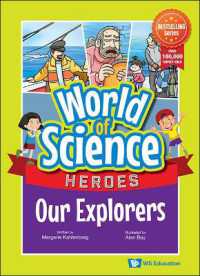- ホーム
- > 洋書
- > 英文書
- > Science / Mathematics
Full Description
In today's world, ensuring the safety and quality of food is more critical than ever. At the same time, the need to reduce the environmental impact of laboratory practices is becoming a top priority across the scientific community. Green Analytical Chemistry in Food Analysis bridges these two essential goals, presenting a comprehensive and forward-thinking guide to apply green chemistry principles in the analytical evaluation of food.
This book is a response to the growing demand for environmentally responsible techniques in food testing - methods that do not sacrifice analytical accuracy, sensitivity, or precision. It explores how green analytical chemistry (GAC) can transform every step of the food analysis process, from sample collection and preparation to separation, detection, and data processing. Through a combination of modern technologies, novel methodologies, and sustainable thinking, the field is redefining how we approach contaminants, residues, and nutritional profiling in food.
Key topics include
Green Sample Preparation: Minimizing solvent usage and adopting eco-friendly extraction methods
Sustainable Separation and Detection: Innovations in chromatography, spectrometry, titrimetry, and gravimetry with reduced chemical and energy footprints
Cleaner Alternatives: Natural indicators, alternative solvents, and energy-efficient instruments
Miniaturization and Direct Analysis: Reducing waste through compact, high-efficiency systems
Advanced Tools: Chemometric and computational approaches to streamline processes and reduce laboratory interventions
Real-World Applications: Case studies focusing on pesticide residues, mycotoxins, heavy metals, and other critical food contaminants
Scoring Greenness: Calculation of green score using different available metrices with examples
Concepts and Principles: Concepts and principles of GAC explained in simplest manner to understand in first time.
Whether you're an analytical chemist, food scientist, environmental researcher, or student, this book offers valuable insights into implementing greener methods that meet today's strict regulatory standards while supporting global sustainability goals. Green Analytical Chemistry in Food Analysis is more than a technical resource - it is a call to action for a cleaner, safer, and more responsible future in food science.
Contents
Series Preface. About the Editors. List of Contributors. Preface. 1 Green Analytical Chemistry: Concept and Scope. 2 Scoring of Green Analytical Technique: Evaluation of Degree of Greenness. 3 Green Spectrometric Techniques: Principles and Concepts. 4 Green Extraction Techniques. 5 Green Sample Separation. 6 Green Gravimetric Techniques: Energy-Saving Techniques. 7 Green Titrimetric Technique. 8 Green Chromatographic Techniques. 9 Noninvasive Technology. 10 Biosensor and Nanosensor Technology in Food Analysis. 11 Green Analytical Techniques for Estimation of Fat. 12 Green Analytical Techniques for Estimation of Protein. 13 Green Analytical Techniques for Estimation of Carbohydrate in Food. 14 Green Analytical Techniques: Vitamin Analysis. 15 Green Analytical Techniques: Food Additives Analysis. 16 Green Analytical Technique for Trace Metal Analysis. 17 Green Analytical Techniques for Pesticide Residue Analysis in Food: Recent Advances and Future Perspectives. 18 Green Analytical Techniques for Mycotoxin Analysis. 19 Green Analytical Techniques for Antibiotic Residues. Index.





